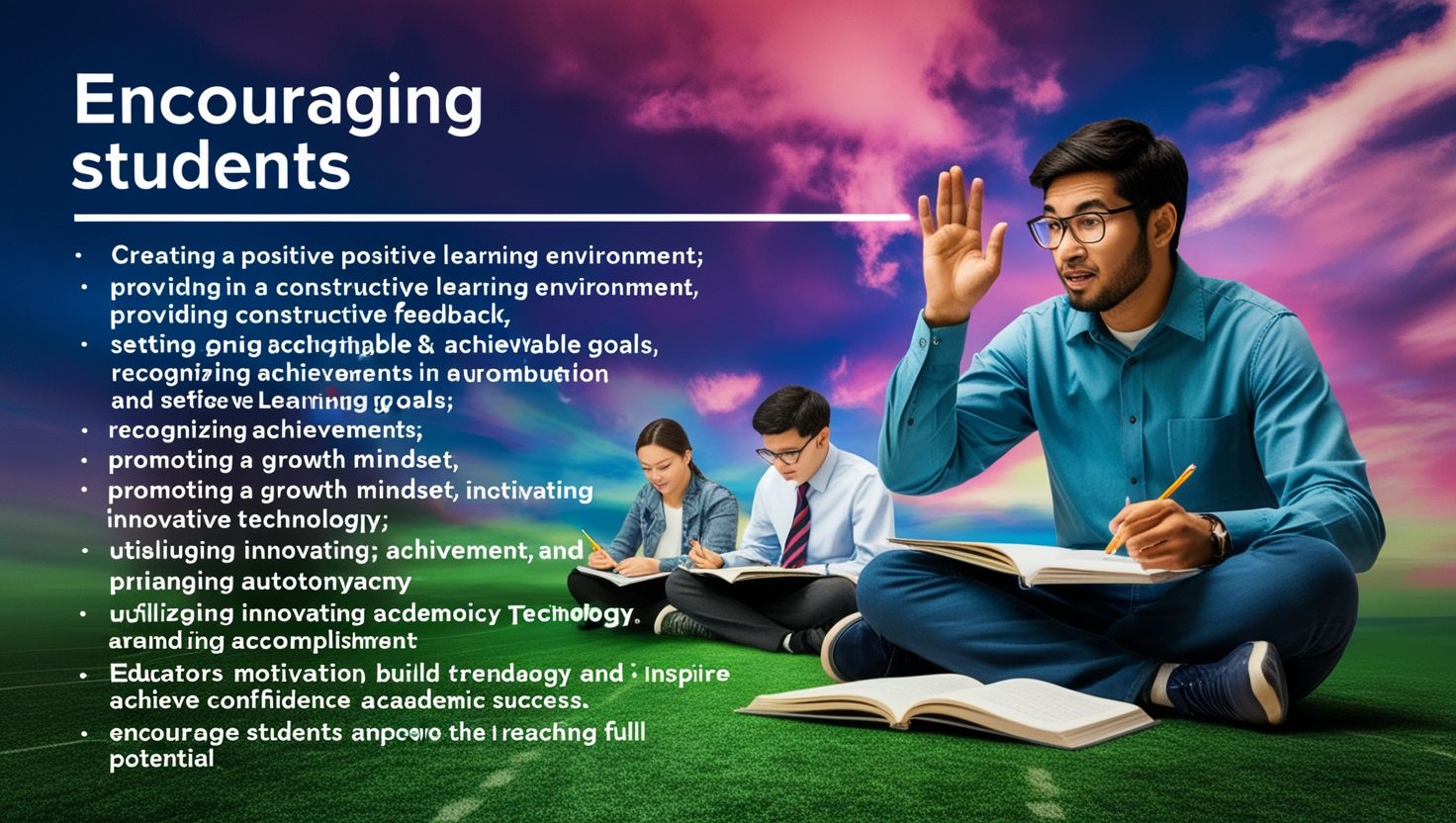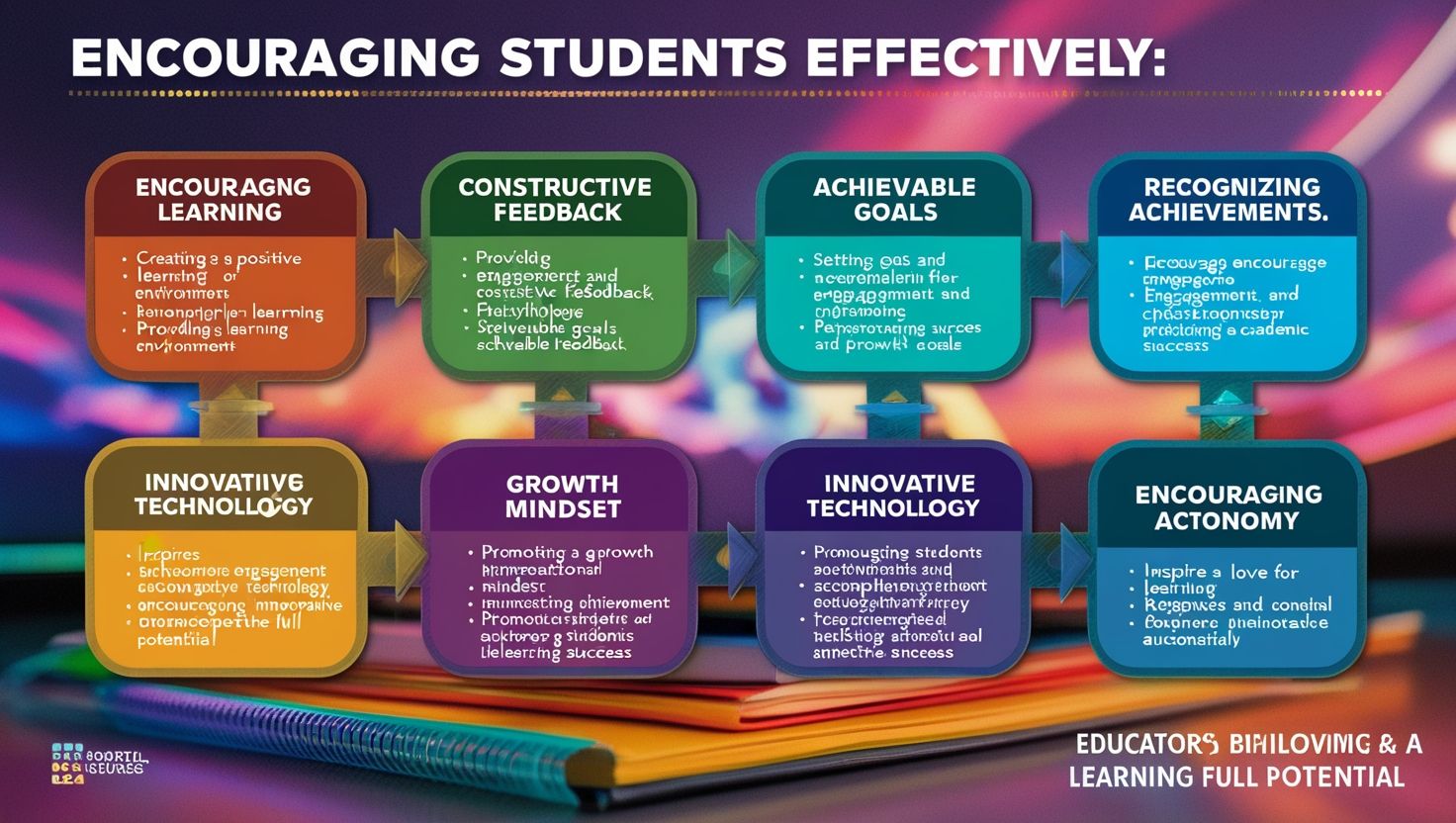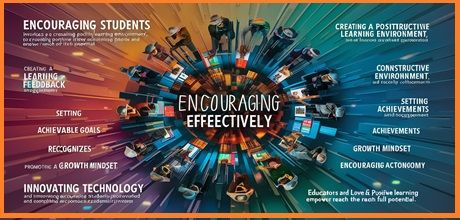Student Encouragement Strategies Encouraging students is essential for fostering motivation, engagement, and academic success. Effective encouragement strategies help students develop a positive attitude towards …
Student Encouragement Strategies Fostering Motivation and Success
Student Encouragement Strategies Encouraging students is essential for fostering motivation, engagement, and academic success. Effective encouragement strategies help students develop a positive attitude towards learning, build self-confidence, and enhance their overall educational experience. This essay explores various strategies for encouraging students, including creating a positive learning environment, providing constructive feedback, setting achievable goals, recognizing achievements, and promoting a growth mindset.

Creating a Positive Learning Environment
A positive learning environment is fundamental to student encouragement. This involves creating a classroom atmosphere where students feel safe, respected, and valued. Key elements include:
- Building Strong Relationships: Establishing strong teacher-student relationships is crucial. Teachers should show genuine interest in their students’ lives, listen to their concerns, and provide support. This helps build trust and makes students feel valued and understood.
- Promoting Inclusivity: An inclusive classroom environment respects and values diversity. Teachers should encourage all students to participate and ensure that everyone feels included, regardless of their background or abilities.
- Fostering Collaboration: Encouraging teamwork and collaboration among students helps build a sense of community. Group projects, peer reviews, and cooperative learning activities promote mutual support and motivation.
Providing Constructive Feedback
Constructive feedback is essential for student growth and encouragement. Effective feedback should be timely, specific, and focused on improvement. Strategies for providing constructive feedback include:
- Highlighting Strengths: Start by acknowledging what the student has done well. Positive reinforcement boosts confidence and encourages students to continue their efforts.
- Offering Specific Suggestions: Provide clear, actionable suggestions for improvement. Instead of general comments like “good job” or “needs work,” offer specific guidance on how the student can enhance their performance.
- Using a Balanced Approach: Balance positive and corrective feedback. This helps maintain students’ motivation while addressing areas that need improvement.

Setting Achievable Goals
Goal setting is a powerful tool for student encouragement. It helps students focus their efforts, track their progress, and experience a sense of accomplishment. Effective goal-setting strategies include:
- SMART Goals: Encourage students to set SMART goals – Specific, Measurable, Achievable, Relevant, and Time-bound. Clear and realistic goals are more likely to be achieved and provide a roadmap for success.
- Short-Term and Long-Term Goals: Help students set both short-term and long-term goals. Short-term goals provide immediate targets to work towards, while long-term goals give students a vision for their future.
- Regular Review and Adjustment: Regularly review and adjust goals as needed. Celebrate achievements and help students re-evaluate their goals to keep them motivated and on track.
Recognizing Achievements
Recognizing and celebrating student achievements is a crucial aspect of encouragement. It reinforces positive behavior and motivates students to continue striving for success. Effective strategies for recognizing achievements include:
- Public Recognition: Acknowledge students’ achievements publicly, whether in the classroom, during school assemblies, or through newsletters. Public recognition boosts students’ self-esteem and encourages their peers.
- Personalized Praise: Offer personalized praise that acknowledges the individual effort and progress of each student. This shows students that their unique contributions are valued.
- Incentives and Rewards: Use incentives and rewards to recognize achievements. This can include certificates, small prizes, or special privileges. Ensure that rewards are meaningful and linked to specific accomplishments.
Promoting a Growth Mindset
Encouraging a growth mindset – the belief that abilities and intelligence can be developed through effort and perseverance – is essential for fostering resilience and motivation in students. Strategies for promoting a growth mindset include:
- Encouraging Effort Over Talent: Praise students for their effort and hard work rather than innate talent. This reinforces the idea that persistence and dedication lead to improvement.
- Modeling a Growth Mindset: Teachers should model a growth mindset by sharing their own experiences with learning and overcoming challenges. Demonstrating a willingness to learn from mistakes sets a positive example for students.
- Teaching the Brain’s Plasticity: Educate students about the brain’s ability to grow and change through learning. Understanding that intelligence is not fixed can motivate students to embrace challenges and persist in the face of setbacks.

Incorporating Technology and Innovative Methods
Leveraging technology and innovative teaching methods can also enhance student encouragement. Modern educational tools and techniques can make learning more engaging and accessible. Strategies include:
- Interactive Learning Tools: Utilize interactive tools such as educational apps, online simulations, and multimedia resources to make learning more engaging and interactive. Tools like Kahoot!, Quizlet, and Nearpod can make lessons more dynamic and fun.
- Flipped Classroom Model: Implement the flipped classroom model, where students review instructional content at home and engage in interactive activities in class. This encourages active participation and allows for personalized support.
- Gamification: Incorporate gamification elements into the classroom. Using game-based learning techniques, such as point systems, leaderboards, and badges, can motivate students and make learning more enjoyable.
Encouraging Student Autonomy
Promoting student autonomy helps students take ownership of their learning and fosters intrinsic motivation. Strategies for encouraging autonomy include:
- Offering Choices: Provide students with choices in their learning activities, assignments, and projects. Allowing students to choose topics that interest them increases engagement and motivation.
- Encouraging Self-Assessment: Teach students to assess their own work and set goals for improvement. Self-assessment fosters self-awareness and encourages students to take responsibility for their learning.
- Facilitating Independent Learning: Encourage students to explore topics independently and pursue their own interests. Independent learning projects and research assignments can deepen students’ understanding and passion for the subject matter.
Conclusion
Encouraging students effectively requires a multifaceted approach that includes creating a positive learning environment, providing constructive feedback, setting achievable goals, recognizing achievements, promoting a growth mindset, incorporating technology, and encouraging student autonomy. By implementing these strategies, teachers can foster a supportive and motivating classroom atmosphere that empowers students to reach their full potential. Ultimately, the goal is to inspire a love of learning and help students develop the skills and confidence they need to succeed both academically and in life.

dxpvv3
The next time I read a blog, I hope that it doesnt disappoint me as much as this one. I mean, I know it was my choice to read, but I actually thought youd have something interesting to say. All I hear is a bunch of whining about something that you could fix if you werent too busy looking for attention.
lqpaju
Some really prize blog posts on this web site, saved to favorites.
I wish to express my appreciation to you just for bailing me out of this type of instance. Just after exploring through the world-wide-web and obtaining thoughts that were not productive, I assumed my life was gone. Existing without the presence of approaches to the issues you’ve solved through your write-up is a crucial case, and the ones that could have negatively affected my career if I had not come across your blog post. Your actual expertise and kindness in playing with all things was valuable. I am not sure what I would’ve done if I hadn’t come upon such a step like this. I can also now look forward to my future. Thanks for your time so much for this reliable and results-oriented help. I won’t be reluctant to recommend the sites to any individual who should have recommendations about this issue.
Greetings! Very helpful advice on this article! It is the little changes that make the biggest changes. Thanks a lot for sharing!
I believe this website contains some rattling excellent info for everyone :D. “America is not merely a nation but a nation of nations.” by Lyndon B. Johnson.
I wanted to draft you one very small remark to help thank you very much once again just for the fantastic basics you have featured on this website. It is tremendously open-handed of you to allow openly what a lot of folks might have sold for an e book to help with making some profit on their own, especially now that you might have done it if you ever desired. The secrets also served as a fantastic way to recognize that other people online have the identical dreams just like my personal own to realize somewhat more with respect to this condition. I am certain there are many more pleasant occasions up front for individuals that look over your website.
I regard something genuinely interesting about your weblog so I saved to my bookmarks.
Hi there, just became aware of your blog through Google, and found that it’s really informative. I am going to watch out for brussels. I will appreciate if you continue this in future. Lots of people will be benefited from your writing. Cheers!
I have been browsing online more than 3 hours today, yet I never found any interesting article like yours. It is pretty worth enough for me. In my view, if all webmasters and bloggers made good content as you did, the internet will be much more useful than ever before.